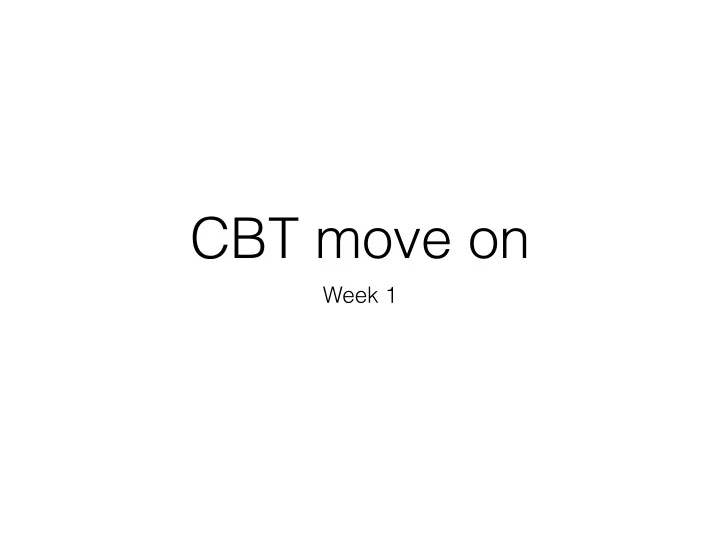

CBT move on Week 1
WHAT IS CBT?
“I think therefore I am.” – René Descartes "You," your joys and your sorrows, your memories and your ambitions, your sense of personal identity and free will, are in fact no more than the behaviour of a vast assembly of nerve cells and their associated molecules. The astonishing hypothesis "You're nothing but a pack of neurones."
“A ¡TYPE ¡OF ¡‘ PSYCHOTHERAPEUTIC ’ ¡TREATMENT ¡THAT ¡HELPS ¡ PATIENTS ¡TO ¡ UNDERSTAND ¡THE ¡THOUGHTS ¡AND ¡FEELINGS ¡THAT ¡ INFLUENCE ¡ BEHAVIOURS ” -‑ ¡HYPNOTHERAPY ¡CENTRE ¡OF ¡EXCELLENCE CBT = Image from: London Counselling Directory Image from: Frederick Chiropractors • Psychotherapy - the treatment of mental disorder by psychological rather than medical means.
CBT is commonly used to treat a wide range of disorders, such as: Image from: awakening2hypnosis ADHD Image from: londoncounsellingdirectory.com Image from: integrativepsychiatrist.net Image from:Alternative way to recovery
During the course of the treatment People learn how to: • identify and • change • destructive/disturbing • thought patterns that have • negative influence on • behaviour.
Brief history of CBT
History of CBT • Merging of several theories and research • CBT have roots within: • Cognitive (Sigmund Freud & Alfred Adler), • Behaviourism (Ivan Pavlov, John B. Watson, B.F.Skinner, Joseph Wolpe & Albert Bandura) • mixed with Rational Emotive Behaviour Therapy (Albert Ellis) and • Multimodal Therapy (Arnold Lazarus)
B.F. Skinner Lawrence kohlberg Jean Piaget Ivan Pavlov John B Watson Alfred adler Sigmund freud Behaviourists & Developmental Psychologists Psychoanalysts Aaron Beck Albert Bandura albert ellis C B Joseph Wolpe T Rational Emotive Behavioural Therapy Aaron Beck formed the basis of Cognitive Therapy we practice today.
CBT basics • Our thoughts and feelings play a fundamental role in our behaviour • i.e. a person spending a lot of time thinking about plane crashes, runway accidents and other such air disasters may find themselves avoiding air travel.
CBT basics - goal • The goal of CBT is to teach patients that while they cannot control every aspect of the world around them, they can take control of how they interpret and deal with things in their environment. • CBT is usually a short-term treatment option , it is often more affordable than some other types of therapy. • CBT is also empirically supported and has been shown to effectively help patients overcome a wide variety of maladaptive behaviours.
Types of CBT • CBT include’s a wide range of treatment approaches for emotional disorders, along a continuum from structured individual psychotherapy to self- help material. • There are a number of different approaches to CBT that are regularly used by mental health professionals. These types include: ︎ Cognitive Therapy • ︎ Multimodal Therapy • ︎ Rational Emotive Therapy •
Components of CBT • People often experience thoughts or feelings that reinforce faulty beliefs . • Such beliefs can result in problematic behaviours that can affect numerous life areas, including family, romantic relationships, work and academics.
Negative thoughts about self! Maybe I should avoid social Results in missed situations opportunities
How to combat these destructive thought patterns and behaviours 1. Identify the problematic beliefs This stage is known as Functional Analysis - learning how thoughts, feelings and situations can contribute to maladaptive behaviours. The process can be difficult, especially for those who struggle with introspection, but it can ultimately lead to self-discovery and insights that are an essential part of the treatment process.
2. Focus on the actual behaviours contributing to the problem. This second stage the client begins to learn and practice new skills that can then be put into use in real-world situations. i.e. a person suffering from drug addiction might start practicing new coping skills and rehearsing ways to avoid or deal with social situations that might trigger a relapse.
CBT is a gradual process • Take incremental steps towards behavioural change. • i.e. someone suffering from social anxiety might start by simply imagining him/herself in an anxiety- provoking situation. Next the client might start practicing conversations with friends, family and acquaintances. This way, progressively working towards a larger goal, the process seems less daunting and the goals easier to achieve.
Uses of CBT • Best for clients comfortable with introspection . • Ready and willing to spend time and a lot of effort analysing their thoughts and feelings. • learning about how internal states impact outward behaviour and practicing this new learned behaviour into daily life. • One of the greatest benefits is that it helps clients develop coping skills that can be useful both now and in the future.
Key names to remember understanding the development of this type of therapy: Donald Meichenbaum Judith Beck Albert Ellis Aaron Beck
Basic characteristics of all cognitive therapies: 1. A collaborative relationship between client and therapist 2. The premise that psychological distress is largely a function of disturbances in cognitive processes 3. A focus in changing conditions to produce desired changes in affect and behaviour 4. A present-centred, time-limited focus 5. An active and directive stance by the therapist 6. An educational treatment focusing on specific and structured target problems 7. Emphasises on the role of homework 8. Place responsibility on the client to assume an active role during and outside therapy sessions 9. Emphasise developing a strong therapeutic alliance 10. Draw from a variety of cognitive and behavioural strategies to bring about change.
• Therapists help clients to examine the manner in which they understand themselves and the world and to experiment with new ways of behaving. • Cognitive Behavioural therapy is based in the assumption that reorganising one’s self statements will result in a corresponding reorganisation of one’s behaviour. • Behavioural techniques such as operant conditioning, modelling and behaviour rehearsal can be applied to the cognitive behaviour approaches.
Week 2 1. Levels of change 2. Stages of change model 3. Readiness to change ruler 4. Involving others within CBT
Recommend
More recommend